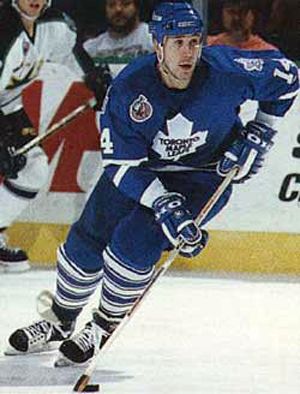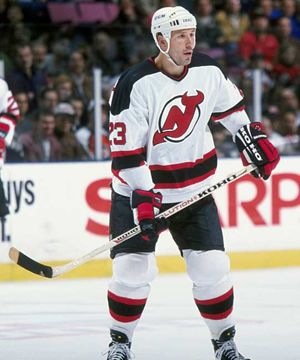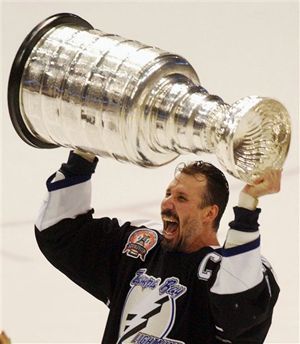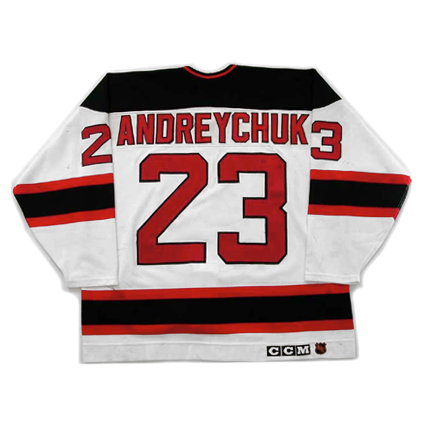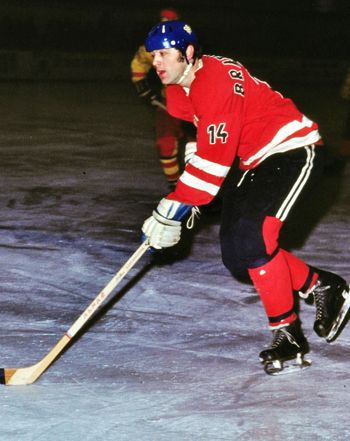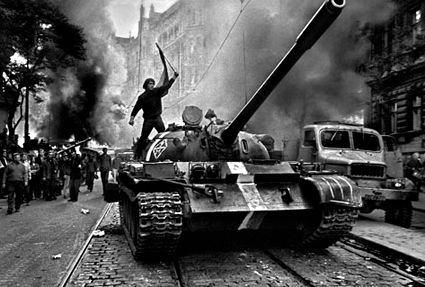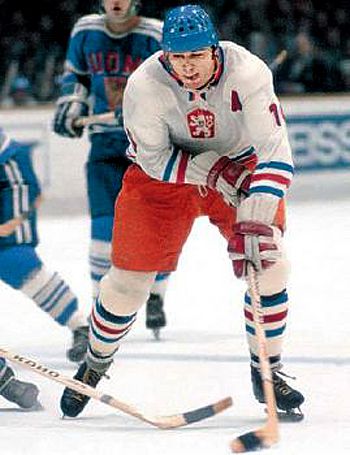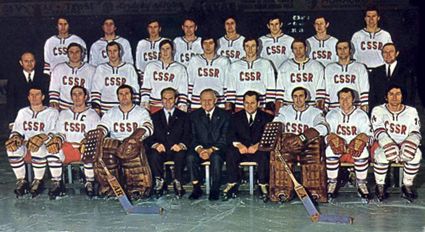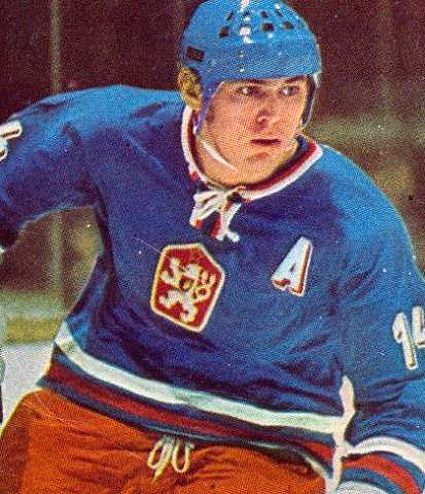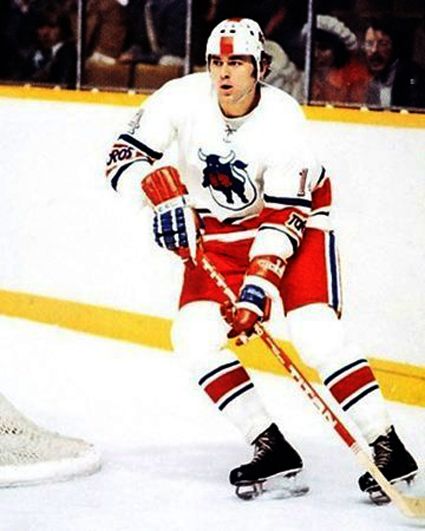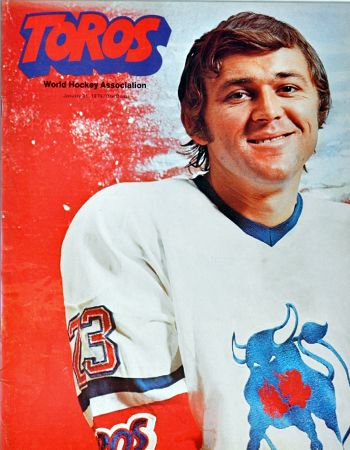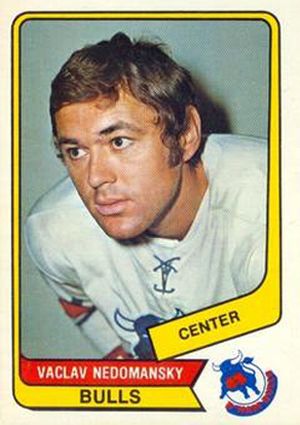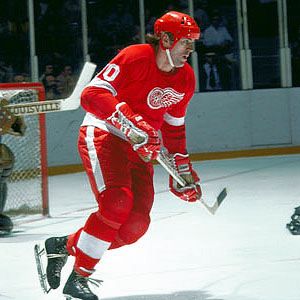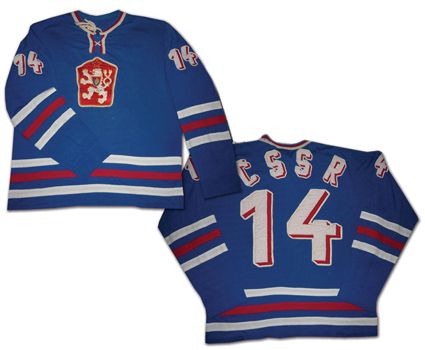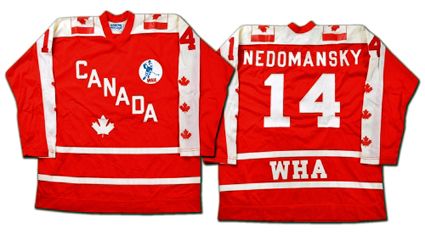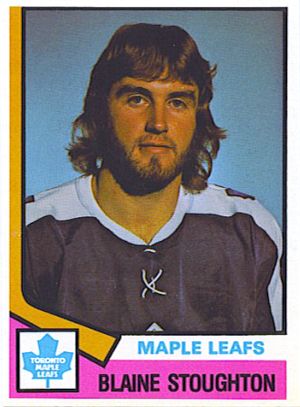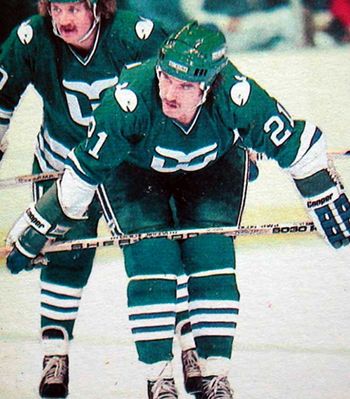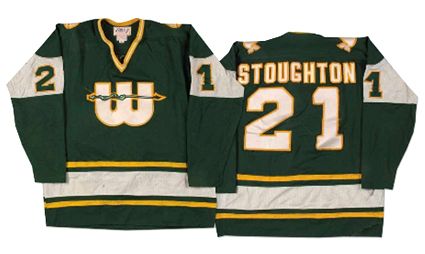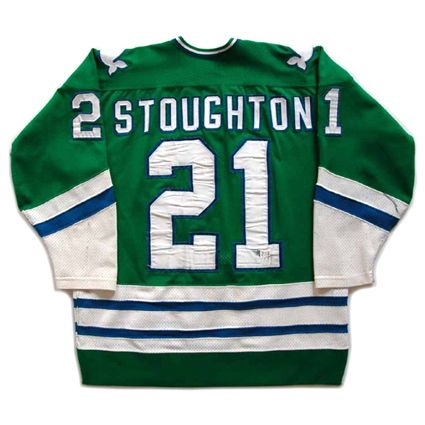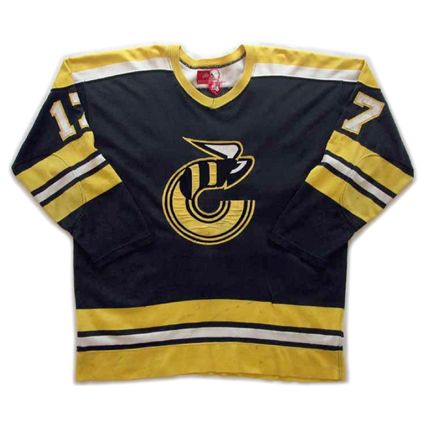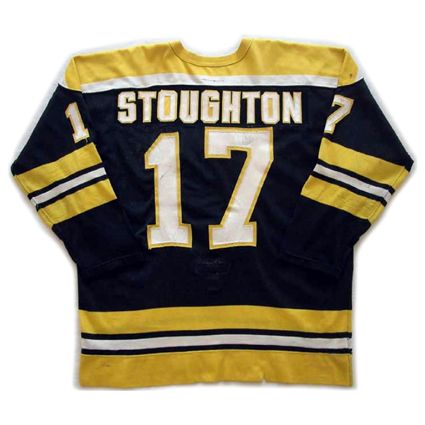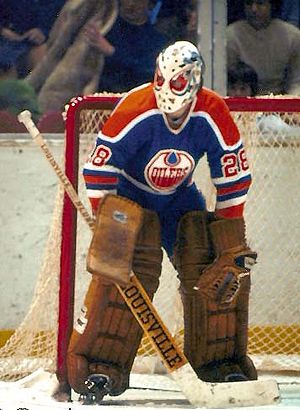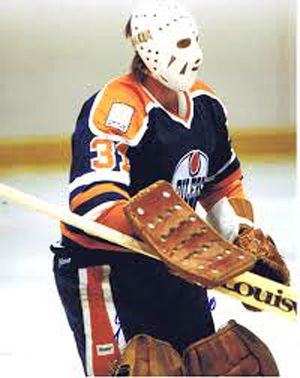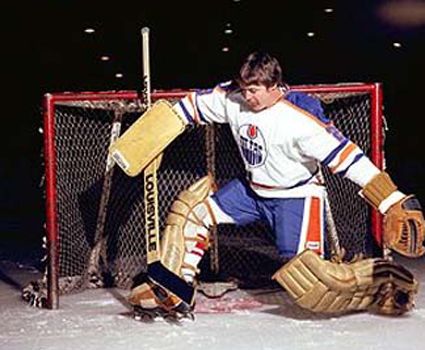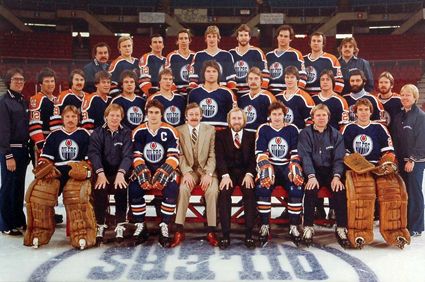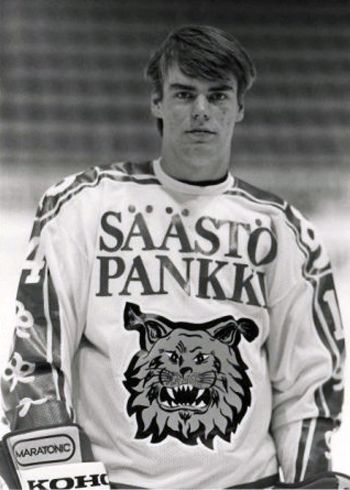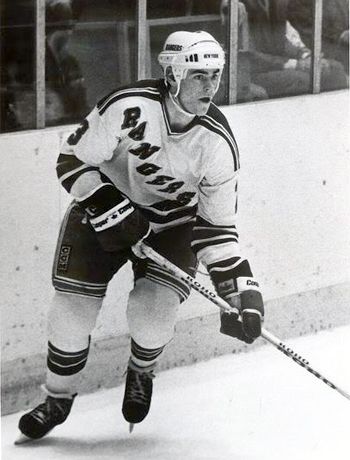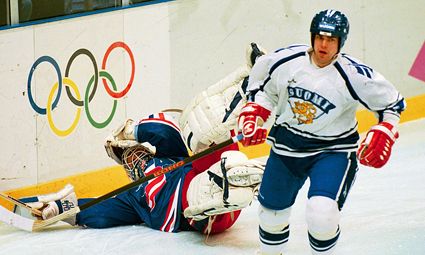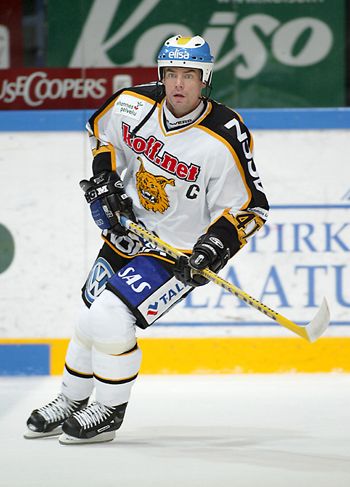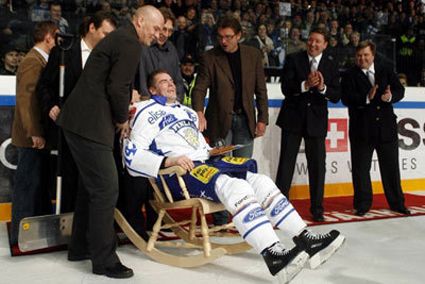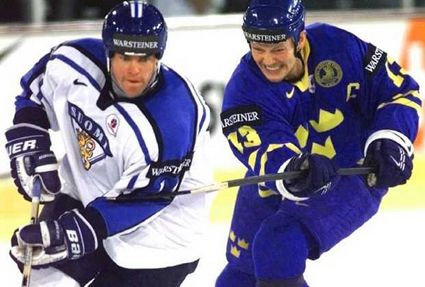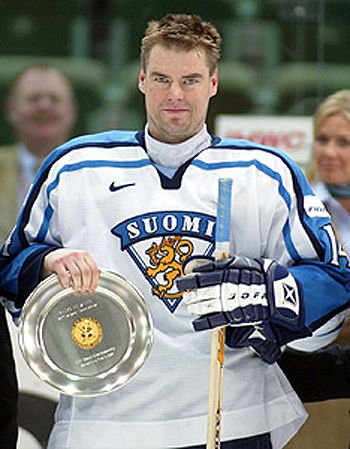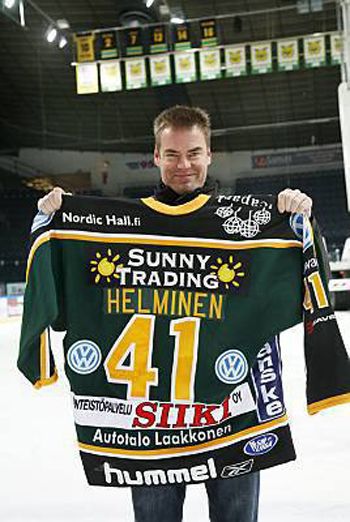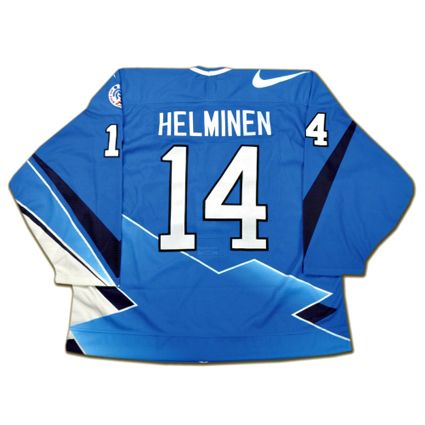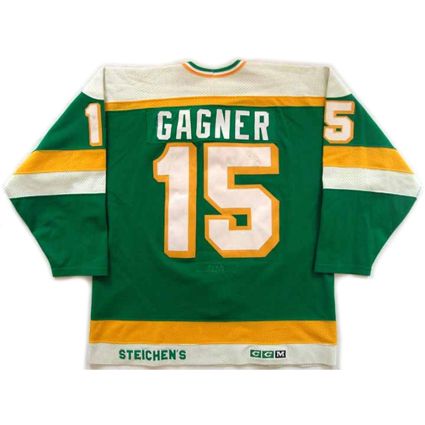Saturday, March 15, 2014
1996-97 New Jersey Devils Dave Andreychuk Jersey
Drafted 16th overall in the 1982 NHL Entry Draft after playing his junior hockey with the Oshawa Generals, Dave Andreychuk began his NHL career with the Buffalo Sabres, where he would play for the first 11 years of his carer. While with the Sabres, he was a steady, reliable goal scorer.
During his first abbreviated season of 43 games, he would score 14 goals, but from then on tally a minimum of 25 goals with a high of 41 in 1991-92 while with Buffalo. During the 1992-93 season, he was traded to the Toronto Maple Leafs.
He completed the season with Toronto without missing a beat, totaling a career high 54 goals divided between the two clubs and followed that with 53 goals the following season. Two seasons later Andreychuk would be traded to the New Jersey Devils at the trade deadline.
Now a veteran of 14 NHL seasons, his goal scoring pace was no longer what it had once been in the high scoring 1980's and early 90's with a change in the role he was asked to play, but he continued to score at a steady pace near the 20 goal mark for the remainder of his career.
During his first full season with the Devils, Andreychuk would score his 500th NHL goal on this date in 1997 in a 3-2 win over the Washington Capitals, becoming the 26th player to reach that important milestone.
After two more seasons with the Devils, Andreychuk would sign with the Boston Bruins as a free agent for the 1999-00 season, only to be traded late in the season along with Ray Bourque to the Colorado Avalanche. After finishing the year with Colorado, Andreychuk would return to Buffalo as a free agent for the 2000-01 season.
His second stay in Buffalo would be considerably shorter than his first, as he played for the Sabres just one season before moving on to the Tampa Bay Lightning for 2001-02 as a free agent to provide the club with some needed veteran leadership. Steady and reliable as always, Andreychuk would play 82 games that season, followed by 72 and again 82, while scoring 20 or more all three seasons.
While never a threat to win the Stanley Cup with the Sabres, Andreychuk made it as far as the conference finals with Toronto twice (1993 & 1994) and again with Colorado in 2000, but came up short of the finals all three times. Finally, while with Tampa Bay, Andreychuk had his chance in 2004. Coming from behind 3 games to 2, Tampa Bay rallied with a double overtime win on the road in Game 6 and captured the Stanley Cup 2-1 at home in Game 7. As the team captain, Andreychuk had the honor of accepting the cup on behalf of the team, to the delight of many around the league, happy to see the veteran finally reach the pinnacle of the sport after 22 seasons before a championship, tying a league record.
He would play one more partial season in 2005-06 prior to retiring with 1,639 games played (5th all-time), 640 goals, one of 18 players with 600 or more goals and still 13th on the all-time list, 698 assists and 1,338 points, currently 27th all-time. He also holds the career record for Most Power Play Goals with 274.
Today's featured jersey is a 1996-97 New Jersey Devils Dave Andreychuk jersey as worn while he scored his 500th NHL goal on this date in 1997.
Club president and general manager Lou Lamoriello has steadfastly refused to change the now classic Devils jersey. Lamoriello joined the Devils in 1987, inheriting their red and green jerseys in the process. For the 1992-93 season the team changed their color scheme by changing the green to black and simplifying their jerseys striping pattern and have stuck with with look ever since, including the name and number fonts.
They have also refused to introduce any sort of alternate third jersey and were able to maintain their traditional sweaters even through the transition to the new Reebok jerseys introduced in 2007.
Today's video segment begins with Andreychuk scoring his 500th NHL goal on this date in 1997.
Our next video is Andreychuk finally being able to lift the Stanley Cup after 22 seasons of trying.
Labels:
Andreychuk Dave,
New Jersey Devils
Friday, March 14, 2014
1969 Czechoslovakia Vaclav Nedomansky Jersey
Born on this date in 1944, Vaclav Nedomanský first played for HC Slovan Bratislava in his native Czechoslovakia in the 1962-63 season. A center, he showed his offensive talent at an early age, scoring 20 goals in 31 games in his sophomore season of 1963-64 at the age of 19.
Established as a top level talent, he quickly settled into the routine of the best European players, competing for his club team each season followed by suiting up for his country at the World Championships each spring, augmented by the Olympics every four years. This pattern for Nedomanský began in 1964-65 when he made his first World Championship appearance for Czechoslovakia at the 1965 World Championships.
Going up against the might of the Soviet Union, who were in the midst of a nine year run as world champions, Nedomanský won silver medals in his first two tries, 1965 and 1966.
He had an outstanding domestic season for Slovan in 1966-67 when he scored a league leading 40 goals and 60 points in just 36 games to lead the league in scoring for the first time.
During a 31 goal, 46 point campaign in 1967-68, Nedomanský made his first Olympic appearance in 1968 in Grenoble, France where his 5 goals and 7 points in 7 games helped the Czechs to a silver medal.
Over the course of the next three seasons the cycle of domestic season followed by the World Championships continued, highlighted by a 48 point season in 1968-69 in 36 games and an emotional defeat of the Soviet Union in 1969, as the Soviets had invaded Czechoslovakia in 1968 following the reforms granting more freedoms to the Czech citizens by President Alexander Dubcek by loosening restrictions on the media, art, speech and travel during the Prague Spring of 1968. Dubcek had been arrested and the country taken over by 750,000 troops in the space of 24 hours, which resulted in 108 Czech and Slovak deaths and 500 injuries to primarily civilians. Despite being arrested and taken to Moscow, Dubček was allowed to remain in office and was returned to Prague a week later.
The invasion also cost Czechoslovakia the 1969 World Championships, which they were scheduled to host, but the tournament had to be moved to Sweden in light of the situation. So when the World Championships arrived seven months later, the games between Czechoslovakia and the Soviets held an importance beyond sport.
Spurned on by their emotions, the Czechs won the game as legendary goalkeeper Vladimir Dzurilla held the Soviets at bay for a 2-0 shutout, sending thousands of Czechoslovakians into the streets back in Prague in celebration.
After three more wins, the two teams were to meet again with both teams now at 7-1 atop the standings. Nedomanský scored to give the Czechs a 2-0 lead, but the Soviets fought back to tie it at 2-2. In the third period the Czechs got two goals within two minutes at the midway point of the period and held on to win 4-3, becoming the first team to ever defeat the Soviet Union twice in a single IIHF tournament.
After a bronze medal in 1970, he led the Czechoslovak Extraliga in points in 1971 with 55 as well as leading the World Championships in goals with 8 as the Czechs took home another World Championship silver medal in 1971.
A strong 1971-72 season as Nedomanský lead the league in both goals (31) and points (52) for Bratislava. 1972 also saw a change in international hockey, as for the first time both the Olympics and a separate World Championships were held during the same year, as previous to 1972, the World Championships were not held during Olympic years.
Nedomanský and the Czechs defeated Japan 8-2 to moved to the Final Round, where they went 3-2, defeating Poland, Finland and Sweden to take home the bronze in February.
Later in April, the Czechs hosted the World Championships in Prague, where they opened their tournament with a demolition of Switzerland 19-1! They then defeated Sweden and West Germany before battling the Soviet Union to a 3-3 draw, followed by a win over Finland. They then faced each of the same five teams again in the double round robin format and reeled off wins over Switzerland Sweden, West Germany, a vital 3-2 defeat of the Soviets and capped off their schedule with a 8-2 win against the Finns to finish undefeated at 9-0-1, sending the home fans into the streets in celebration as they captured the third gold medal in their history and first since 1949 and ending a decade of Soviet dominance. During the World Championships, Nedomanský had 9 goals to lead the tournament and 15 points in 9 games played.
For the 1972-73 season, the world of hockey began to change, as the NHL expanded by two teams to combat the arrival of the upstart World Hockey Association, which began play with 12 teams, leaving 14 new teams looking to fill roughly 280 roster positions.
Meanwhile, in Czechoslovakia, it was business as usual, with Nedomanský playing his 11th season for Slovan Bratislava, although his production slipped to 22 goals, but still averaged over a point per game. The 1973 World Championships saw him bring home another medal, this one a bronze.
The 1973-74 season saw Nedomanský set a career highs in goals with 46 and points with 74, easily topping his previous high of 60 points to lead the league in both categories once again. Additionally, the Czechs had handed the Soviets their worst ever defeat at the 1974 World Championships by a score of 7-2, known as "The Perfect Game". At the conclusion of the tournament, during which the Czechs won silver, Nedomanský was named the Top Forward following his tournament high 10 goals and 13 points in 10 games, cementing his reputation as one of the finest hockey players in the world not in the North American professional ranks thanks to his consistently strong domestic and World Championship performances.
Meanwhile in North America, the WHA had grown to 14 teams and the NHL to 18, another 6 clubs and 120 roster spots to fill. The WHA in particular, began turning it's attention to Europe for talent, highlighted by the arrival of Swedes Ulf Nilsson and Anders Hedberg in Winnipeg. While the Soviet players were considered impossible targets, many teams began to ponder the possibility of obtaining a player from Czechoslovakia, as they had seen what conditions were like on the other side of the Iron Curtain during their travels.
One team in position to make such an long shot a possibility was the Toronto Toros of the WHA, who had established contacts with agents in Eastern Europe and had owner in John Bassett Jr.'s very politically well connected father John Bassett Sr. on their side.
When the Toros and the NHL's Atlanta Flames failed in their negotiations for Nedomansky's legal release from Czechoslovakia, Nedomanský, his wife and son obtained a travel visa and packed minimal luggage, so as not to draw any undue attention among government officials, and headed off "on vacation" to Switzerland.
Once in Bern, he contacted the Toros and the Flames, who immediately sent representatives over to negotiate for his services. Toronto won out and quickly ran to the Canadian consulate to obtain the proper paperwork for their new player and his family to come to Canada, making him the first player from a communist country to defect.
Meanwhile, back in Czechoslovakia, it was as if he never existed despite being the national team captain for ten years, as former teammates were afraid to even speak his name for fear of who might be listening.
He would score three goals in his first five games with the Toros as the club set as all-time attendance record of 14,000 in his first game.
The rest of his first season in Toronto was a success, as he scored 41 goals and 81 points in 78 games for third on the team in scoring. He topped that the next year with a team leading 98 points while finishing third in the league with 56 goals.
Still, the Toros struggled at the gate and endured a lot of difficulties being tenants at Maple Leaf Gardens, home of their NHL competition. As a result, Bassett relocated the franchise to Birmingham, Alabama, where they were renamed the Bulls. Nedomanský was less than excited for the relocation to someplace so culturally different and it was reflected in his play, as he dropped to 36 goals and 69 points in 1976-77.
Just 12 games into the 1977-78 season, and having scored just 2 goals, Nedomanský was traded to the Detroit Red Wings of the NHL, the first ever inter-league trade.
Nedomanský would play five seasons in Detroit, with highs of 38 goals in 1978-79 and 74 points the following season. As he past 35 years of age, his production began to wane and he was signed as a free agent by the New York Rangers for the 1982-83 season, but was claimed by the St. Louis Blues as the season was about to begin. After 22 games with St. Louis, he was traded to the Rangers where he competed in the final 35 games of his career.
In all, Nedomanský scored 534 goals in Czechoslovakia, the WHA and the NHL combined while leading the Czechoslovak Extraliga in goals three times and points for times. Additionally, he added another 78 goals during the Olympics and World Championships, where he earned a silver and bronze Olympic medals and one gold, four silver and three bronze - eight total out of a possible nine - World Championship medals.
Nedomanský was inducted into the IIHF Hall of Fame in 1997 as well as the Czech Hockey Hall of Fame.
Here is a special treat, footage of Czechoslovakia beating the Soviet Union at the 1969 World Championships, showing footage from the game as well as the heroes welcome they received when they returned home.
Established as a top level talent, he quickly settled into the routine of the best European players, competing for his club team each season followed by suiting up for his country at the World Championships each spring, augmented by the Olympics every four years. This pattern for Nedomanský began in 1964-65 when he made his first World Championship appearance for Czechoslovakia at the 1965 World Championships.
Going up against the might of the Soviet Union, who were in the midst of a nine year run as world champions, Nedomanský won silver medals in his first two tries, 1965 and 1966.
He had an outstanding domestic season for Slovan in 1966-67 when he scored a league leading 40 goals and 60 points in just 36 games to lead the league in scoring for the first time.
Nedomansky played 12 years for Slovan Bratislava
During a 31 goal, 46 point campaign in 1967-68, Nedomanský made his first Olympic appearance in 1968 in Grenoble, France where his 5 goals and 7 points in 7 games helped the Czechs to a silver medal.
Over the course of the next three seasons the cycle of domestic season followed by the World Championships continued, highlighted by a 48 point season in 1968-69 in 36 games and an emotional defeat of the Soviet Union in 1969, as the Soviets had invaded Czechoslovakia in 1968 following the reforms granting more freedoms to the Czech citizens by President Alexander Dubcek by loosening restrictions on the media, art, speech and travel during the Prague Spring of 1968. Dubcek had been arrested and the country taken over by 750,000 troops in the space of 24 hours, which resulted in 108 Czech and Slovak deaths and 500 injuries to primarily civilians. Despite being arrested and taken to Moscow, Dubček was allowed to remain in office and was returned to Prague a week later.
Soviet tanks invade Prague
The invasion also cost Czechoslovakia the 1969 World Championships, which they were scheduled to host, but the tournament had to be moved to Sweden in light of the situation. So when the World Championships arrived seven months later, the games between Czechoslovakia and the Soviets held an importance beyond sport.
“We said to ourselves, even if we have to die on the ice, we have to beat them,” said team captain Jozef Golonka many years later. “We received hundreds of telegrams from fans back home when we arrived in Stockholm. Almost all of them said: ‘Beat the Soviets. You don’t have to beat anyone else. Just beat the Soviets.’”
Spurned on by their emotions, the Czechs won the game as legendary goalkeeper Vladimir Dzurilla held the Soviets at bay for a 2-0 shutout, sending thousands of Czechoslovakians into the streets back in Prague in celebration.
Once again, a reported half a million Czechoslovakians took to the streets across the country in what was first a celebration of their hockey team's victory, but, particularly in Prague, evolved into a protest against the Soviet military which had continued their occupation of Czechoslovakia since the previous August.
From Time Magazine April 11, 1969:
Overcome by a vicarious sense of triumph, a huge and excited crowd swarmed into Prague’s Wenceslas Square. One happy hockey fan carried a poster that read BREZHNEV 3, DUBČEK 4. The crowd chanted, “We’ve beaten you this time!” Someone shouted, “The Russian coach will go to Siberia!”
Those particular protests turned violent when not only Soviet military units were attacked and their vehicles burned, but the offices of the Soviet airline Aeroflot were ransacked.
The uprising was suppressed by the Czech military, which was now under control of hardliners from the Communist Party, and the events were used as a pretext to oust the remaining leaders of the Prague Spring from power, Dubček in particular.
Drained by their efforts, the Czechs lost to Sweden 1-0 and dropped to the bronze medal, which was determined by goal differential, with the gold going to the Soviets and the silver to Sweden, who all finished with an 8-2 record.
Drained by their efforts, the Czechs lost to Sweden 1-0 and dropped to the bronze medal, which was determined by goal differential, with the gold going to the Soviets and the silver to Sweden, who all finished with an 8-2 record.
After a bronze medal in 1970, he led the Czechoslovak Extraliga in points in 1971 with 55 as well as leading the World Championships in goals with 8 as the Czechs took home another World Championship silver medal in 1971.
A strong 1971-72 season as Nedomanský lead the league in both goals (31) and points (52) for Bratislava. 1972 also saw a change in international hockey, as for the first time both the Olympics and a separate World Championships were held during the same year, as previous to 1972, the World Championships were not held during Olympic years.
Nedomanský and the Czechs defeated Japan 8-2 to moved to the Final Round, where they went 3-2, defeating Poland, Finland and Sweden to take home the bronze in February.
Later in April, the Czechs hosted the World Championships in Prague, where they opened their tournament with a demolition of Switzerland 19-1! They then defeated Sweden and West Germany before battling the Soviet Union to a 3-3 draw, followed by a win over Finland. They then faced each of the same five teams again in the double round robin format and reeled off wins over Switzerland Sweden, West Germany, a vital 3-2 defeat of the Soviets and capped off their schedule with a 8-2 win against the Finns to finish undefeated at 9-0-1, sending the home fans into the streets in celebration as they captured the third gold medal in their history and first since 1949 and ending a decade of Soviet dominance. During the World Championships, Nedomanský had 9 goals to lead the tournament and 15 points in 9 games played.
The World Champion 1972 Czechoslovak National Team
For the 1972-73 season, the world of hockey began to change, as the NHL expanded by two teams to combat the arrival of the upstart World Hockey Association, which began play with 12 teams, leaving 14 new teams looking to fill roughly 280 roster positions.
Meanwhile, in Czechoslovakia, it was business as usual, with Nedomanský playing his 11th season for Slovan Bratislava, although his production slipped to 22 goals, but still averaged over a point per game. The 1973 World Championships saw him bring home another medal, this one a bronze.
The 1973-74 season saw Nedomanský set a career highs in goals with 46 and points with 74, easily topping his previous high of 60 points to lead the league in both categories once again. Additionally, the Czechs had handed the Soviets their worst ever defeat at the 1974 World Championships by a score of 7-2, known as "The Perfect Game". At the conclusion of the tournament, during which the Czechs won silver, Nedomanský was named the Top Forward following his tournament high 10 goals and 13 points in 10 games, cementing his reputation as one of the finest hockey players in the world not in the North American professional ranks thanks to his consistently strong domestic and World Championship performances.
Meanwhile in North America, the WHA had grown to 14 teams and the NHL to 18, another 6 clubs and 120 roster spots to fill. The WHA in particular, began turning it's attention to Europe for talent, highlighted by the arrival of Swedes Ulf Nilsson and Anders Hedberg in Winnipeg. While the Soviet players were considered impossible targets, many teams began to ponder the possibility of obtaining a player from Czechoslovakia, as they had seen what conditions were like on the other side of the Iron Curtain during their travels.
One team in position to make such an long shot a possibility was the Toronto Toros of the WHA, who had established contacts with agents in Eastern Europe and had owner in John Bassett Jr.'s very politically well connected father John Bassett Sr. on their side.
When the Toros and the NHL's Atlanta Flames failed in their negotiations for Nedomansky's legal release from Czechoslovakia, Nedomanský, his wife and son obtained a travel visa and packed minimal luggage, so as not to draw any undue attention among government officials, and headed off "on vacation" to Switzerland.
Once in Bern, he contacted the Toros and the Flames, who immediately sent representatives over to negotiate for his services. Toronto won out and quickly ran to the Canadian consulate to obtain the proper paperwork for their new player and his family to come to Canada, making him the first player from a communist country to defect.
Meanwhile, back in Czechoslovakia, it was as if he never existed despite being the national team captain for ten years, as former teammates were afraid to even speak his name for fear of who might be listening.
He would score three goals in his first five games with the Toros as the club set as all-time attendance record of 14,000 in his first game.
The rest of his first season in Toronto was a success, as he scored 41 goals and 81 points in 78 games for third on the team in scoring. He topped that the next year with a team leading 98 points while finishing third in the league with 56 goals.
Just 12 games into the 1977-78 season, and having scored just 2 goals, Nedomanský was traded to the Detroit Red Wings of the NHL, the first ever inter-league trade.
Nedomanský would play five seasons in Detroit, with highs of 38 goals in 1978-79 and 74 points the following season. As he past 35 years of age, his production began to wane and he was signed as a free agent by the New York Rangers for the 1982-83 season, but was claimed by the St. Louis Blues as the season was about to begin. After 22 games with St. Louis, he was traded to the Rangers where he competed in the final 35 games of his career.
In all, Nedomanský scored 534 goals in Czechoslovakia, the WHA and the NHL combined while leading the Czechoslovak Extraliga in goals three times and points for times. Additionally, he added another 78 goals during the Olympics and World Championships, where he earned a silver and bronze Olympic medals and one gold, four silver and three bronze - eight total out of a possible nine - World Championship medals.
Nedomanský was inducted into the IIHF Hall of Fame in 1997 as well as the Czech Hockey Hall of Fame.
Today's featured jersey is a 1969 Czechoslovakia National Team Václav Nedomanský jersey as worn in the emotionally charged 1969 World Championships when Czechoslovakia defeated the Soviet Union twice, thrilling the Czechs back at home who were still under occupation.
While many would expect Czechoslovakia to wear red, they have in fact, worn blue off an on during their history, including periods of use in the 1930's, 40's and 50's as well as from 1965 to 1974 before a permanent change to red jerseys in 1975.
This striking jersey is an all-time classic, with the simplicity of the striping, lace up collar, heraldic main crest as well as the unique font for the numbers, which are then drop shadowed and outlined, a treatment which is also carried over to the CSSR lettering on the back, which is then radially arched, an early precursor to player names on the back, which did not become a regular part of NHL jerseys until the mid 1970's.
Bonus jersey: Today's bonus jersey is a 1976 WHA All-Star Game Václav Nedomansky jersey. In 1976, the WHA used a unique format which saw the all-stars from the Canadian based teams (regardless of the players citizenship) taking on a team of all-stars from teams based in the United States, which was won by Canada 6-1 in Cleveland, Ohio.
Bonus jersey: Today's bonus jersey is a 1976 WHA All-Star Game Václav Nedomansky jersey. In 1976, the WHA used a unique format which saw the all-stars from the Canadian based teams (regardless of the players citizenship) taking on a team of all-stars from teams based in the United States, which was won by Canada 6-1 in Cleveland, Ohio.
Here is a special treat, footage of Czechoslovakia beating the Soviet Union at the 1969 World Championships, showing footage from the game as well as the heroes welcome they received when they returned home.
Labels:
Czechoslovakia,
Nedomanský Václav
Thursday, March 13, 2014
1978-79 New England Whalers Blaine Stoughton Jersey
Blaine Stoughton, born on this date in 1953, began his road to the professional hockey ranks with four seasons with the Flin Flon Bombers of the WCHL, with the first being the 1969-70 season. His point totals his first two seasons were 39 and then 50, before a giant leap upward for the 1971-72 season when he scored more goals than he had points the previous season with 60 goals and 126 points to lead the WCHL in scoring. He also added an additional 121 penalty minutes to go along with his offensive output. The following season he came close to matching his previous year with 58 goals and 118 points.
Having been born at the right time, Stoughton was turning pro during the NHL vs WHA war for players, which led to an enormous increase in salaries for the players. Stoughton was thus drafted 14th overall by the Quebec Nordiques of the WHA and 7th overall by the NHL's Pittsburgh Penguins.
PIttsburgh won out for the rights to sign Stoughton and he was assigned to their minor league club in the AHL, the Hershey Bears, with whom he scored 40 points in 47 games before a call-up to the Penguins for 34 games.
Just prior to the start of the 1974-75 season, Stoughton was traded to the Toronto Maple Leafs in a deal which sent Rick Kehoe to Pittsburgh. In 78 games with Toronto, he scored 23 goals and 37 points. Despite the 20 goal season, he split time in 1975-76 between Toronto (43 games, 17 points) and the Oklahoma City Blazers of the Central Hockey League (30 games, 36 points).
For the 1976-77 season, Stoughton jumped to the WHA's Cincinnati Stingers, who had obtained his rights from the Nordiques in the WHA expansion draft. The move to the free wheeling WHA was a revelation for Stoughton, who teamed with Rick Dudley and Rich Leduc to form the high powered "LSD Line".
Stoughton and Leduc each had 52 goals to finish fourth in the league, with Leduc's 107 points 7th overall and Stoughton's 102 good for 9th, while Dudley reached 88. Despite their success, the line would not stay together long, as 30 games into the 1977-78 season, Stoughton and Gilles Marotte were traded to the Indianapolis Racers after Stoughton did not fit into new head coach Jacques Demers system.
The change to Indianapolis was brief, as Stoughton finished out the season with the Racers, scoring just 13 goals in 47 games, and after playing the first 25 games of the 1978-79 season, the Racers , who were on the verge of folding, was sold to the New England Whalers where he finished out what would prove to be the final days of the WHA as well.
For the 1979-80 season, the Whalers were part of a complex deal which saw four surviving WHA clubs enter the NHL and Stoughton's rights revert back to Toronto, only to be claimed by the newly renamed Hartford Whalers in the subsequent Expansion Draft.
Stoughton thrived during his first season back in the NHL, finishing eighth in scoring with 100 points while leading the league with 56 goals, becoming only the second player after Bobby Hull to score 50 goals in both the WHA and the NHL. The Whalers even made the NHL playoffs that season, only to have Stoughton break his leg during their opening game against the Montreal Canadiens. It would also be the last playoff game of his career, as the Whalers would not qualify for the playoffs for another six seasons.
He returned to play 71 games of the 1980-81 season after ending a contract holdout, scoring 43 goals and 73 points. He again reached the 50 goals mark in 1981-82 with 52, which placed him 6th in the league and allowed him to lead the team in scoring for the only time with 91 points. He also made his only NHL All-Star Game appearance that season.
After his fourth consecutive 40 goal season, scoring 45 in 1982-83, Stoughton played his final 54 games with the Whalers in 1983-84 prior to being traded to the New York Rangers as the Whalers then all-time franchise goals leader in late February of 1984.
His 5 goals for the Rangers in 14 games would be the last of his NHL career, as he spent the 1984-85 season with the New Haven Nighthawks of the American Hockey League when he did not make the Rangers roster in training camp and no other teams claimed him.
After two seasons away from pro hockey, Stoughton would play one final stint as a pro, with 15 games of the 1987-88 season with HC Asiago of the Italian Serie A.
Stoughton would play 526 NHL games, scoring 258 goals and 449 points, as well as an additional 89 goals and 179 points in the WHA for a total of 628 points.
Today's featured jersey is a 1978-79 New England Whalers Blaine Stoughton jersey as worn during the Whalers final season in the WHA prior to the league's demise and it's entry into the NHL for 1979-80 season.
After their first two seasons wearing green and white and a circular crest on their road jerseys, the Whalers added gold trim to their color scheme and simplified the crest on their jerseys to just the "W" bisected with a harpoon for the remainder of their time in the WHA, with only a subtle change to the waist striping for their last two WHA seasons, going from a wide white stripe with gold trim to a "Northwestern" pattern, meaning the gold trim was moved outward from the white waist stripe, allowing the green jersey color to separate the white from the gold.
Bonus jersey: Today's bonus jersey is a 1979-80 Hartford Whalers Blaine Stoughton jersey. When the club was forced to change it's name from "New England" to "Hartford" at the request of the Boston Bruins, the Whalers adopted a new whale tail logo, altered their color scheme from green and gold to green and blue and unveiled an entirely new set of modernized jerseys that they would wear for the next 13 seasons with only minor detail changes, although the "Pucky the Whale" patches were discontinued in 1985-86.
Extra bonus jersey: Today's extra bonus jersey is a 1976-77 Cincinnati Stingers Blaine Stoughton jersey. The Stingers wore essentially the same jerseys for their all-to-brief four year run. With the Stingers name lending itself to a multi-stripe theme, it's a wonder the Stingers jerseys were as reserved as they were.
The Stingers logo is a wonderful piece of graphic design and looks as modern today as it did when it was first conceived, and has always been a favorite of ours.
Today's video section begins with Stoughton discussing his time with the Whalers.
Next, the WHA Legends feature on Stoughton showing him and his mustache in action.
Having been born at the right time, Stoughton was turning pro during the NHL vs WHA war for players, which led to an enormous increase in salaries for the players. Stoughton was thus drafted 14th overall by the Quebec Nordiques of the WHA and 7th overall by the NHL's Pittsburgh Penguins.
PIttsburgh won out for the rights to sign Stoughton and he was assigned to their minor league club in the AHL, the Hershey Bears, with whom he scored 40 points in 47 games before a call-up to the Penguins for 34 games.
Just prior to the start of the 1974-75 season, Stoughton was traded to the Toronto Maple Leafs in a deal which sent Rick Kehoe to Pittsburgh. In 78 games with Toronto, he scored 23 goals and 37 points. Despite the 20 goal season, he split time in 1975-76 between Toronto (43 games, 17 points) and the Oklahoma City Blazers of the Central Hockey League (30 games, 36 points).
For the 1976-77 season, Stoughton jumped to the WHA's Cincinnati Stingers, who had obtained his rights from the Nordiques in the WHA expansion draft. The move to the free wheeling WHA was a revelation for Stoughton, who teamed with Rick Dudley and Rich Leduc to form the high powered "LSD Line".
Stoughton and Leduc each had 52 goals to finish fourth in the league, with Leduc's 107 points 7th overall and Stoughton's 102 good for 9th, while Dudley reached 88. Despite their success, the line would not stay together long, as 30 games into the 1977-78 season, Stoughton and Gilles Marotte were traded to the Indianapolis Racers after Stoughton did not fit into new head coach Jacques Demers system.
The change to Indianapolis was brief, as Stoughton finished out the season with the Racers, scoring just 13 goals in 47 games, and after playing the first 25 games of the 1978-79 season, the Racers , who were on the verge of folding, was sold to the New England Whalers where he finished out what would prove to be the final days of the WHA as well.
For the 1979-80 season, the Whalers were part of a complex deal which saw four surviving WHA clubs enter the NHL and Stoughton's rights revert back to Toronto, only to be claimed by the newly renamed Hartford Whalers in the subsequent Expansion Draft.
Stoughton thrived during his first season back in the NHL, finishing eighth in scoring with 100 points while leading the league with 56 goals, becoming only the second player after Bobby Hull to score 50 goals in both the WHA and the NHL. The Whalers even made the NHL playoffs that season, only to have Stoughton break his leg during their opening game against the Montreal Canadiens. It would also be the last playoff game of his career, as the Whalers would not qualify for the playoffs for another six seasons.
He returned to play 71 games of the 1980-81 season after ending a contract holdout, scoring 43 goals and 73 points. He again reached the 50 goals mark in 1981-82 with 52, which placed him 6th in the league and allowed him to lead the team in scoring for the only time with 91 points. He also made his only NHL All-Star Game appearance that season.
After his fourth consecutive 40 goal season, scoring 45 in 1982-83, Stoughton played his final 54 games with the Whalers in 1983-84 prior to being traded to the New York Rangers as the Whalers then all-time franchise goals leader in late February of 1984.
Stoughton during the 1982-83 season wearing
the controversial long hockey pants
His 5 goals for the Rangers in 14 games would be the last of his NHL career, as he spent the 1984-85 season with the New Haven Nighthawks of the American Hockey League when he did not make the Rangers roster in training camp and no other teams claimed him.
After two seasons away from pro hockey, Stoughton would play one final stint as a pro, with 15 games of the 1987-88 season with HC Asiago of the Italian Serie A.
Stoughton would play 526 NHL games, scoring 258 goals and 449 points, as well as an additional 89 goals and 179 points in the WHA for a total of 628 points.
Today's featured jersey is a 1978-79 New England Whalers Blaine Stoughton jersey as worn during the Whalers final season in the WHA prior to the league's demise and it's entry into the NHL for 1979-80 season.
After their first two seasons wearing green and white and a circular crest on their road jerseys, the Whalers added gold trim to their color scheme and simplified the crest on their jerseys to just the "W" bisected with a harpoon for the remainder of their time in the WHA, with only a subtle change to the waist striping for their last two WHA seasons, going from a wide white stripe with gold trim to a "Northwestern" pattern, meaning the gold trim was moved outward from the white waist stripe, allowing the green jersey color to separate the white from the gold.
photo courtesy of Classic Auctions
Bonus jersey: Today's bonus jersey is a 1979-80 Hartford Whalers Blaine Stoughton jersey. When the club was forced to change it's name from "New England" to "Hartford" at the request of the Boston Bruins, the Whalers adopted a new whale tail logo, altered their color scheme from green and gold to green and blue and unveiled an entirely new set of modernized jerseys that they would wear for the next 13 seasons with only minor detail changes, although the "Pucky the Whale" patches were discontinued in 1985-86.
Extra bonus jersey: Today's extra bonus jersey is a 1976-77 Cincinnati Stingers Blaine Stoughton jersey. The Stingers wore essentially the same jerseys for their all-to-brief four year run. With the Stingers name lending itself to a multi-stripe theme, it's a wonder the Stingers jerseys were as reserved as they were.
The Stingers logo is a wonderful piece of graphic design and looks as modern today as it did when it was first conceived, and has always been a favorite of ours.
Today's video section begins with Stoughton discussing his time with the Whalers.
)
Next, the WHA Legends feature on Stoughton showing him and his mustache in action.
)
Wednesday, March 12, 2014
1980-81 Edmonton Oilers Ron Low Jersey
When the Edmonton Oilers, and the other three World Hockey Association teams, joined the NHL in 1979 they were allowed to protect only two skaters and two goaltenders.
The Oliers protected goalies Dave Dryden and Eddie Mio, who had played in 63 and 22 games respectively in the Oilers previous season.
The 13 players to remain on the team from their final WHA season were skaters Wayne Gretzky, Blair MacDonald, Stan Weir, Brett Callighen, Dave Hunter, Ron Chipperfield, Risto Siltanen, Al Hamilton, Dave Semenko, Bill Flett, Peter Driscoll and the goaltending duo of Mio and Dryden.
The Oilers first NHL game saw them go down to defeat against the Chicago Black Hawks on the road, but they earned points in their next five games with two pairs of ties sandwiching a win versus their WHA cousins the Quebec Nordiques, the Oilers first win in the NHL.
Two wins and 11 losses in their next 13 games showed the Oilers that life in the NHL was not going to be easy, but they responded with four wins, three ties and two losses in their next nine. Two wins and five losses closed out the 1979 calendar year, leaving the Oilers at 9-19-7 for 25 points.
January saw the Oilers go 6-6-3 and they closed out a 5-7-2 month of February with a loss, which began a skid of six straight losses which began with a 4-2 loss to the Buffalo Sabres on Leap Day, February 29th with Mio in goal at home.
They fell to the visiting Vancouver Canucks 5-2 the next day, March 1st, with Jim Corsi getting the start.
The Oilers then began a difficult five game east coast road trip with that season's eventual Stanley Cup champions, the New York Islanders, who defeated Edmonton 6-4 with Mio getting the start before being replaced by Corsi after giving up his third goal four minutes into the second period.
Corsi then took the loss in Montreal two days later followed by Don Cutts starting against the Pittsburgh Penguins only to give way to Corsi after allowing four goals through two periods in an eventual 5-4 loss that extended the losing streak to five games.
Bob Dupuis was called in to stop the bleeding in his NHL debut on hostile ice in Philadelphia. The Oilers gave him a 3-1 lead after two periods only to have the Flyers come storming back with four third period goals to win 5-3, which extended the losing streak to six.
The streak was broken on this date in 1980 with the arrival of goaltender Ron Low, who was obtained from the Nordiques in exchange for Ron Chipperfield on March 11th.
They fell to the visiting Vancouver Canucks 5-2 the next day, March 1st, with Jim Corsi getting the start.
The Oilers then began a difficult five game east coast road trip with that season's eventual Stanley Cup champions, the New York Islanders, who defeated Edmonton 6-4 with Mio getting the start before being replaced by Corsi after giving up his third goal four minutes into the second period.
Eddie Mio
Corsi then took the loss in Montreal two days later followed by Don Cutts starting against the Pittsburgh Penguins only to give way to Corsi after allowing four goals through two periods in an eventual 5-4 loss that extended the losing streak to five games.
Bob Dupuis was called in to stop the bleeding in his NHL debut on hostile ice in Philadelphia. The Oilers gave him a 3-1 lead after two periods only to have the Flyers come storming back with four third period goals to win 5-3, which extended the losing streak to six.
A rare shot of Dupuis in the Oilers goal
The streak was broken on this date in 1980 with the arrival of goaltender Ron Low, who was obtained from the Nordiques in exchange for Ron Chipperfield on March 11th.
Low's Oilers debut on this date in 1980 was a 6-3 victory over the Nordiques in Quebec. Intent on winning, the Oilers got three first period goals, one from Hamilton
early and two late ones 50 seconds apart from Hunter.
The Nordiques would not go away so easily though, and scored two in the first half of the second period, but Dave Lumley put the lead back to two just 35 seconds later. Marc Tardif made it a one goal game after two with his goal for the Nordiques at 14:38.
Gretzky took matters into his own hands during the third period with a pair of unassisted goals, the first at 6:24, his 40th of the season, and an empty netter in the final 30 seconds to end the losing streak. Low's 42 saves in his Edmonton debut set a team record which would stand for 33 years.
Low's debut made the Oilers only the second team in NHL history to use six different goaltenders in one season. Low, in fact, was the fifth different Oilers goaltender in the span of five games! Corsi, Mio, Cutts, Dupuis and finally Low all saw time in goal for Edmonton over the previous 300 minutes of play.
early and two late ones 50 seconds apart from Hunter.
The Nordiques would not go away so easily though, and scored two in the first half of the second period, but Dave Lumley put the lead back to two just 35 seconds later. Marc Tardif made it a one goal game after two with his goal for the Nordiques at 14:38.
Gretzky took matters into his own hands during the third period with a pair of unassisted goals, the first at 6:24, his 40th of the season, and an empty netter in the final 30 seconds to end the losing streak. Low's 42 saves in his Edmonton debut set a team record which would stand for 33 years.
Low's debut made the Oilers only the second team in NHL history to use six different goaltenders in one season. Low, in fact, was the fifth different Oilers goaltender in the span of five games! Corsi, Mio, Cutts, Dupuis and finally Low all saw time in goal for Edmonton over the previous 300 minutes of play.
#1 Cutts, six NHL games, #1 Corsi, 26 NHL games, and #33 Dupuis, in what would prove to be his only NHL start, all began and ended their NHL careers with Edmonton that season, and #28 Dryden, #31 Mio and #30 Low all took turns in the Oilers goal that season.
Not every one of the Oilers six goaltenders
were on hand for that season's team photo!
The arrival of Low sparked the Oilers, as they would finish the season 8-2-1 to qualify for the Stanley Cup playoffs in their first NHL campaign with Low starting all 11 games to close out the season, obviously giving Edmonton some very much needed stability in goal.
Today's featured jersey is a 1980-81 Edmonton Oilers Ron Low jersey as worn in the second half of the season, replacing the knit jerseys with these new mesh ones.
This set of jerseys was known for the very thin letters used for the names on the back.
Not a lot of Ron Low highlights on youtube, but we did Low discussing goaltending and coaching.
Fortunately we weren't looking for Don Cutts...
)
We did, however find these next two videos, the first of which is Bob Dupuis playing goal for Canada at the 1980 Olympics. That's him you see for a half second at the 15 second mark of the video followed by the empty net as he is pulled for an extra attacker in easily the lamest excuse for posting a video ever on Third String Goalie.
This second video is from Italy, with Jim Corsi as one of the commentators, breaking our previous record for The Lamest Excuse Ever for Posting a Video. We assume it's the same Jim Corsi, who does happen to have duel Italian citizenship. There can't be that many guys in Italy named "Jim" who also happen to be involved in ice hockey in Italy, can there?
Labels:
Edmonton Oilers,
Low Ron
Tuesday, March 11, 2014
1996 Finland National Team Raimo Helminen Jersey
After beginning his career in the Ilves Tampere junior system, including making his international debut at the European Junior Championships for Finland in 1982, Raimo Helminen made his debut their senior team in the Finnish SM-liiga for the 1982-83 season with 31 games while he split his time with the junior team that season.
For 1983-84, Helminen, born on this date in 1964, won a silver medal at the World Junior tournament in 1984 and just one month later he made his Olympic debut in Sarajevo, Yugoslavia where the 19 year old appeared in six games, scoring 2 points.
Helminen with Ilves in 1983-84
Helminen finished third in league scoring for Ilves with 21 goals and a career best 57 points in 36 games in 1984-85 as the club won their first league championship in their history. He then made his debut at the 1985 World Championships where he continued his offensive output with 4 goals and 9 points in 10 games.
Helminen had been drafted by the New York Rangers in 1984 and moved to the NHL for the 1985-86 season, appearing in 66 games, scoring 10 goals and 40 points as a rookie. He was back with the Rangers for the 1986-87 season, but things did not go nearly as well, as he only produced 6 points in 21 games and spent time with New Haven in the AHL before a late season trade saw him sent to the Minnesota North Stars for the final 6 games of the season.
New York Ranger Raimo Helminen
Before the next season began, Helminen was back on the international stage, playing for Finland in the 1987 Canada Cup tournament. He was back in Tampere with Ilves, racking up 43 points in 31 games, including 20 goals. He also appeared in his second Olympics, scoring 10 points in 7 games as Finland won their first ever medal with a silver in Calgary.
Helminen while playing for Finland in the late 1980's
Note the green gloves from Ilves
Note the green gloves from Ilves
He gave the NHL another try in 1988-89, this time with the New York Islanders, but his play was hampered by back problems. He would total 24 NHL games that season and another 16 with the Springfield Indians of the AHL, where he averaged a point per game.
For 1989-90, he moved to Malmö IF in the Swedish second division, where he starred with 26 goals and 56 points in 29 games to help Malmö earn a promotion to the Swedish Elitserien for the following season.
Helminen would play the next six seasons for Malmö, which included becoming the first foreign born player to win the Swedish scoring title in 1993, with 42 points in 40 games, and winning a league championship in 1992 and again in 1994, a season during which he scored 20 goals and 54 points in 38 games.
Helminen during his time in Sweden with Malmö
During this time period Helminen played in his third and fourth Olympics in 1992 and again 1994, earning a bronze medal as well as playing in the World Championships in 1992 (silver) and 1994 (silver). He was also a member of the first Finnish World Championship winning team in 1995 when the Finns defeated the Swedes in Sweden, triggering joyous celebrations back home in Finland. Helminen contributed 8 points in 8 games on his way to the gold medal.
Helminen skates away from a sprawling American goaltender
Garth Snow during the 1994 Olympics
Garth Snow during the 1994 Olympics
1996 was also a busy year for him internationally, as he participated in both the World Championships in the spring and then the inaugural World Cup of Hockey that fall prior to returning to Tampere to play for Ilves from 1996-97 onward.
Helminen back with Ilves
He was named Player of the Year in 1998 and named team captain in 1999, a position he would hold through the remainder of his long career. He continued to score at a high pace, reaching 50 points twice and topped 40 five times over the next eight seasons, an impressive feat considering the shorter Finnish season, having never played more than 56 games in any season. During his final season of play in 2007-08, he was the oldest player in the league at 44 years of age.
Helminen during his retirement ceremony
His international career also continued to rack up successes as the Finns were now a nation to be reckoned with. Helminen would play in the 1997 World Championships, the 1998 Olympics (bronze), the 1998 World Championships (silver), the 1999 (silver), 2000 (bronze), 2001 (silver) and 2002 Olympics in Salt Lake City. The 2002 Olympics were Helminen's record sixth Olympic Games.
Helminen battles Mats Sundin of Sweden
during the 1998 World Championships
during the 1998 World Championships
That fall he would play in his 11th and final World Championships to conclude his full international career with one World Championship gold, seven silver (one World Junior, five World Championship and one Olympic) and three bronze medals, two Olympic and one at the World Championship.
He would continue to play for Ilves until the 2007-08 season before announcing his retirement after 751 games, 161 goal and 420 assists for 581 points in Finland as well as 226 games and 199 points in Sweden's Elitserien and another 117 games and 59 points in the NHL.
Helminen holds the record for the most international games at 331, scoring 52 goals and 207 points, with his 155 assists and 207 points being Finnish career records internationally.
Helminen was recognized when he set the
record for most international appearances
record for most international appearances
His number 41 was retired by Ilves and Helminen was inducted into the IIHF Hall of Fame in 2012.
Ilves honored Helminen by retiring his #41
Today's featured jersey is a 1996 Finland National Team Raimo Helminen jersey from the inaugural World Cup of Hockey. This attractive "waving flag" style of jersey marked Nike's entry into being the jersey supplier for the IIHF, which continues to this day. This style was worn through the 1997 World Championships until new styles were debuted for the 1998 Olympics.
Bonus jersey: Today's bonus jersey is a 1987-88 Minnesota North Stars Dave Ganger jersey which was previously worn by Helminen during his six games with the North Stars at the end of the 1986-87 season. During that time period a jersey with so much life remaining it in would generally be reused after simply swapping one player's nameplate for another, giving some jerseys an interesting but sometimes difficult to prove history.
Occasionally, jerseys would also undergo number changes as well, further clouding it's past and requiring nearly forensic examination for evidence of changes in customization to suggest previous wearers.
Here is a look at the career if Helminen followed by an interview with him in Finnish.
Occasionally, jerseys would also undergo number changes as well, further clouding it's past and requiring nearly forensic examination for evidence of changes in customization to suggest previous wearers.
Here is a look at the career if Helminen followed by an interview with him in Finnish.
Labels:
Finland,
Helminen Raimo,
Minnesota North Stars
Subscribe to:
Comments (Atom)


